| "The people of the Earth Kingdom are diverse and strong. They are persistent and enduring." |
| — Iroh to Zuko on the nature of the Earth Kingdom.[1] |
The Earth Kingdom is one of the world's four nations. Spanning an entire continent as well as several subsidiary islands, it is the largest and most populated sovereignty in the world and encompasses much of the eastern hemisphere. The kingdom is ruled by a monarchy which operates under the rule of a king or queen.
The people of the Earth Kingdom are proud and strong and adhere to a philosophy of peaceful coexistence and cooperation with the other nations of the world. Earthbenders use their abilities for defense and industry and fiercely defended their cities against Fire Nation attacks during the Hundred Year War. It also has a large economy based on agriculture and limited industry, though it is not as economically powerful as the Fire Nation, which benefits from advanced technology.
The Earth Kingdom is characterized by significant ethnic and cultural diversity, a consequence of the country's vast territorial expanse. As a result, it suffers from high levels of local autonomy and ethnic conflict, both of which began accelerating as the central government grew weak. Despite this division, the people's recognition of the Earth Kingdom as a single political entity is largely strengthened through the communal belief in a shared history and identity.
The Earth Kingdom long withstood encroachments on their borders in the Fire Nation's century-long imperialist war. Other than the Avatar, the Earth Kingdom was the only real obstacle that hindered the Fire Nation from achieving world domination. Though the Water Tribe aided the Earth Kingdom in the War, the conflict progressed poorly and took a heavy toll on them as the years passed. This continued until the Coup of Ba Sing Se, when Princess Azula of the Fire Nation seized control of the Earth Kingdom capital city, Ba Sing Se.[7] By the following summer, the metropolis was occupied by the Fire Nation military, and although it had previously been asserted that the fall of Ba Sing Se would lead to the disintegration of any remaining Earth Kingdom forces, rebel fighters continued to resist foreign rule. This warranted Fire Lord Ozai's decision of burning the Earth Kingdom to the ground upon the arrival of Sozin's Comet.[8]
By the end of summer 100 AG, Ba Sing Se was liberated from Fire Nation control by the Order of the White Lotus, ending the Fire Nation occupation of the city. This, in combination with the decisive defeat of Phoenix King Ozai, effectively liberated the remaining Fire Nation-controlled regions of the Earth Kingdom.[9]
After the end of the Hundred Year War, numerous Fire Nation colonies throughout the western Earth Kingdom were transformed into the United Republic of Nations, a fifth nation founded by Avatar Aang and Fire Lord Zuko.[10]
Seventy years after the conclusion of the Hundred Year War, the Earth Kingdom continued to be influential in world affairs with a representative on the United Republic Council until the council was dissolved in 171 AG.[11]
At some point before 171 AG, Earth King Kuei was succeeded by his daughter, Earth Queen Hou-Ting. During her reign, roaming bands of barbarians destabilized the provinces, preventing the central government from efficiently raising revenues for the state coffers. Nevertheless, the prosperity of the Middle and Upper Rings of Ba Sing Se continued unabated, with the Dai Li maintaining tight control over the city as it had for centuries.[12]
When the Red Lotus staged an insurrection and killed the Earth Queen, the Earth Kingdom capital was thrown into chaos and anarchy.[13] This upheaval quickly spread to the rest of the nation, causing the Earth Kingdom to fall into disarray[14] with bandits roaming the lands and threatening states.[6]
By 174 AG, the Earth Kingdom, through the efforts of Kuvira and her army, was stabilized enough to restore the monarchy. At the coronation of Prince Wu, Kuvira was supposed to relinquish her power to the reinstated crown. She refused, however, denouncing the king's authority and declaring the archaic Earth Kingdom abolished in favor of an "Earth Empire" under her leadership.[15]
History
Origin
- See also: Era of Raava
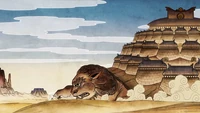
Fortified strongholds formed the basis of early Earth Kingdom architecture.
In the era of Raava, most of the later Earth Kingdom was part of the Spirit Wilds, and its people were forced to survive the wrath of spirits and the untamed nature. The predecessors of the Earth Kingdom found several ways to survive these hardships: Some retreated into cities built atop lion turtles. They received the element of earth from these sentient beings that granted the bending art through energybending. The humans could request the ability whenever they ventured into the Spirit Wilds, to aid in the gathering of food and resources.[16] Others chose a nomadic lifestyle, traveling the wilds and staying at one place only as long as they could. One particular tribe of nomads, however, was able to built a permanent city under the guardianship of the spirit Lady Tienhai in what would become the western Earth Kingdom.[17] Several aspects of life and observances practiced by the predecessors of the first citizens of the Earth Kingdom later became part of the nation's shared culture, notably in the creation of fortified strongholds constructed out of earth, akin to the structures seen in lion turtle cities populated by early Earth Kingdom citizens.[16]
The divided states
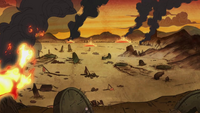
Since Avatar Wan's time, the states of the later Earth Kingdom were constantly at war, struggling for supremacy.
After Avatar Wan closed the spirit portals and most spirits left the mortal world, the lion turtles renounced their roles as protectors of mankind. At this point, the predecessors of the Earth Kingdom left the lion turtle cities in favor of establishing settlements throughout the mainland, while most of the nomads settled down. Soon after, the ancestors of the first Earth Kingdom citizens began to wage wars, inventing the large earth coins as primary weapons for their earthbender warriors to use. Avatar Wan died after intervening in a battle of Earth Kingdom predecessors.[16] Unlike the other nations, where one culture eventually prevailed,[18][19] the later Earth Kingdom was so large and diverse that several cultures and ethnicities emerged and survived to fight for independence and dominance. In the northeast, earthbenders carved a small subterranean settlement out of rocks. Mining and trading beautiful illuminated crystal, the agglomeration began to grow into a city until it reached the surface. Soon after, the catacombs were abandoned and the new metropolis on the surface became the mighty city state of Ba Sing Se.[20] In the west, the two earthbenders in love, Oma and Shu, learned the earthbending techniques from the badgermoles, becoming exceptionally powerful benders. The villages the two were from were at war, however, and eventually Shu was killed in battle. Heartbroken, Oma used her abilities to ensure peace and force the villages to unite. The city they built was named Omashu, and became a powerful city state in its own right.[21] The city of Lady Tienhai prospered and continued to grow as well.[17] In the south, some earthbending nomads made the Si Wong Desert their home, learning to sandbend and finally forming the Sandbender Tribes.[22] They were predated by the beetle-headed merchants, who had lived in the desert since ancient times, and continued to roam it for coming centuries.[20]
Ascension of the Earth Kingdom
Over time, the kings of Ba Sing Se became increasingly powerful and began to unite and subjugate the numerous kingdoms and peoples of the later Earth Kingdom. They left some kings and nobles in power, however, as long as they submitted to Ba Sing Se.[21] Eventually, one king of Ba Sing Se ended the unification wars in victory and crowned himself the first Earth King, not to leave his capital city until his death.[23] Despite Ba Sing Se's victory, the earth monarchs were unable to establish a centralist or authoritarian regime due to the kingdom's sheer size. As result, the Earth Kingdom became a confederate monarchy, divided into several semi-autonomous provinces.[2][24]
Some successive Earth Kings distinguished themselves as brilliant and far-sighted rulers, such as Yi Ming who constructed the Ba Sing Se monorail.[20] In Avatar Yangchen's time, the Earth Kingdom flourished. The city of Lady Tienhai had grown into the grandest city of its time, but the metropolis was struck with disaster when its king caused the guardian spirit's death.[17]
Civil war and constitutional change
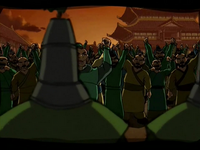
The Peasant Uprising in Ba Sing Se greatly weakened the earth monarchs, resulting in an era of decline and corruption.
The 46th Earth King, however, decided that the vassal rulers and provinces around the kingdom had too much power. Strong-willed and imperious, he intended to change the Earth Kingdom into an absolute monarchy with himself as supreme monarch.[4] This aroused his subjects' anger, and eventually one warlord from the northwest named Chin took up arms to size power from the unpopular king. His revolt quickly escalated into an open civil war, while the Earth King proved incapable of stopping him. Chin's armies conquered the whole kingdom, including mighty cities such as Omashu, until only Ba Sing Se and the home peninsular of Avatar Kyoshi remained free. Chin attempted to force Kyoshi into submission as well, but this led to his death and the creation of Kyoshi Island. Without his leadership, the revolt was suppressed and the Earth King resumed his rule over the whole kingdom.[25] Nevertheless, his inability to deal with Chin's rebellion had repercussions. The peasants of Ba Sing Se, believing the monarchy to be an outdated regime only oppressing them, rose up in defiance. The Peasant Uprising in Ba Sing Se threw the capital into chaos, and only when Kyoshi forced the 46th Earth King to accept a new constitution that limited his power while empowering the common people, the peasants dispersed. In return for the king's reluctant cooperation, Kyoshi created the Dai Li as secret police of Ba Sing Se. These elite earthbenders were intended to defend the Earth Kings' interests by suppressing and imprisoning subversive individuals and groups.[4]
Decline and imperialist aggression
- See also: Fire Nation colonies; Hundred Year War
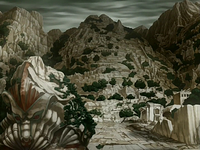
Despite widespread political decline, trade centers like Taku continued to flourish until their destruction by the Fire Nation.
The new constitution greatly weakened the Earth Kings,[4] and the empowered bureaucracy soon became the true ruler of the kingdom. Nevertheless, the monarchs that succeeded the 46th Earth King did nothing to regain their power. Instead, they delegated their authority to the bureaucrats and officials in favor of pleasure-seeking and leisure. Relishing its new power, the bureaucracy grew extremely corrupt over time, and used its power to further its wealth while sidelining the earth monarchs.[5][20][26] The central government's increasing stagnancy and weakness allowed the provincial governments and vassal rulers of the Earth Kingdom to exercise more and more autonomy until they were effectively independent.[2][22][24]
Despite this political weakness, the Earth Kingdom remained an economic and military power to be reckoned with. The west[20] and south[27] of the kingdom continued to flourish, and great cities like Taku and Omashu benefited from trade[20] and industrial growth.[2] The military of the Earth Kingdom was still fiercely loyal to the monarchy, and much of its forces remained reliable and experienced.[28]
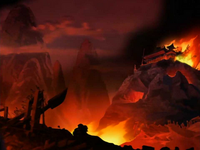
The Earth Kingdom was devastated by the Hundred Year War.
This situation took a change for the worse with Fire Lord Sozin's initial attacks on the Earth Kingdom around 30 BG. The Fire Nation easily conquered a number of cities and resource-rich areas in the northwestern kingdom to transform them into colonial possessions. The Earth Kingdom government proved unable to defend its territories, and only when Avatar Roku intervened Sozin's expansion was stopped. The colonies remained on Earth Kingdom soil, however, and after Roku's death the Fire Lord launched an all-out invasion of the kingdom.[29][30] Western trade centers like Taku were completely destroyed,[20] and by Sozin's death in 20 AG, the Fire Nation had gained a strong foothold in the northwestern continent. The Earth Kingdom military fought with great determination and slowed the Fire Nation advances down as best as it could. Its efforts were not enough to stop the Fire Nation, however, and by 79 AG most of the west and northwest had fallen to the invasion forces. The Earth Kingdom suffered terribly due to the war, experiencing destruction, hunger, and displacement. Thousands of refugees fled into the safety of Ba Sing Se, swelling the slums of the Lower Ring.[28]
Conspiracy and fall
- See also: Conspiracy of Ba Sing Se; Coup of Ba Sing Se
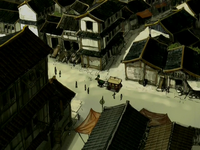
The situation of the Earth Kingdom population worsened due to the war.
In 79 AG, the 51st Earth King died, leaving only his four-year old son to succeed him. The ambitious Grand Secretariat of Ba Sing Se Long Feng recognized his chance to seize power over the kingdom, and made child-king Kuei his puppet. Using the Dai Li, Long Feng suppressed knowledge about the war in order to maintain social order and a stable economy.[5] However, outside the safety of the walls and away from the watchful Dai Li, disorder in the midst of the war was pervasive; in some areas, various officials and soldiers sometimes abused their power by bullying and extorting the local population.[24][31] In other areas, citizens were largely left to fend for themselves.[25]
The war, meanwhile, went increasingly bad for the Earth Kingdom. The Fire Nation advanced east and south, subjugating the west, the shoreline of the West Lake and much of the south. In 94 AG, the Fire Nation Army under Crown Prince Iroh reached the Outer Wall of Ba Sing Se, and began the six hundred-day Siege of Ba Sing Se. Even though the Crown Prince's troops breached the Outer Wall, they retreated after the commander's son Lu Ten was killed in action. Nevertheless, the siege was a disaster for the Earth Kingdom, as it had not only lost large quantities of resources and manpower, but also received a crushing blow to its population's morale after Ba Sing Se was proven not to be impenetrable.[24]
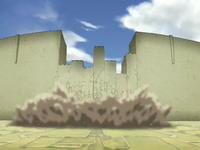
The Dai Li brought the walls of Ba Sing Se to the ground, marking the fall of the Earth Kingdom.
The Earth Kingdom finally fell five years later, after a time of hard fighting that saw the loss of Omashu, the last stronghold in the west. After Avatar Aang had forcefully ended the Conspiracy of Ba Sing Se, Earth King Kuei's power was briefly restored and Long Feng imprisoned. Despite this, the Dai Li remained loyal to Long Feng, as the secret police feared that the king would deprive it of its power.[23] At the same time, the Fire Nation Crown Princess Azula and her team infiltrated the capital. Long Feng and Azula began to cooperate to end Kuei's reign and the Avatar's life, culminating in the Coup of Ba Sing Se. Azula and the Dai Li forced the king into exile, only to betray Long Feng and claim the city in the name of the Fire Nation. The Dai Li's betrayal thus led to the fall of Ba Sing Se, and with it, the Earth Kingdom.[7][32]
Rebellion and reformation
The Fire Nation military used this opportunity to invade the remaining Earth Kingdom, but despite the fall of the central government, Earth Kingdom citizens continued to resist. Rebellions began to spread, while remnants of the Earth Kingdom military remained a threat to Fire Nation rule. The Fire Nation was unable to suppress the revolts,[8] and on the Day of Black Sun the rebels managed to liberate several cities such as Omashu.[33] Soon after, Avatar Aang defeated Fire Lord Ozai, ending the Hundred Year War with the victory of the Earth Kingdom.[9] Kuei returned to the throne, and the Earth Kingdom government was reformed with the Earth King regaining the power his predecessors had lost.[30][34]
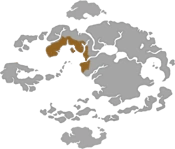
Earth King Kuei ceded Earth Kingdom territory to the United Republic of Nations.
Together with the Avatar and Fire Lord Zuko, Kuei started the Harmony Restoration Movement to remove the Fire Nation colonies from Earth Kingdom soil and resume peaceful cooperation between the different nations. The announcement of the Harmony Restoration Movement triggered a great celebration in Ba Sing Se. Initially, the decolonization was successful and without incidents, but after one year the oldest colonies were to be disbanded. As these cities were over one hundred years old, their population was by then ethnically mixed and deeply rooted in the country.[30] As result, there were political complications that threatened to restart the Great War when Kuei attempted to forcefully remove the colonies, believing the lands to be rightfully part of the Earth Kingdom. Only when Avatar Aang intervened the conflict was resolved by granting the colonies complete autonomy.[10][34] Eventually, the colonies were transformed into the United Republic of Nations,[35] and the Earth King agreed to cede large parts of the northwestern kingdom to the new sovereign country.[12]
Dissolution and forced reunification
- See also: Anarchy in the Earth Kingdom
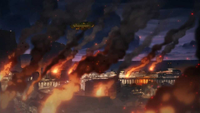
After the assassination of the Earth Queen, the Earth Kingdom fell into a state of anarchy.
Fomented by increasing social conflicts under Earth Queen Hou-Ting's authoritarian regime, the Red Lotus' assassination of the Earth Queen sparked an open revolt of Ba Sing Se's lower class citizens. As a result, the central government collapsed, with violent unrest soon spreading throughout the whole kingdom.[36] Almost all royal artifacts were lost in the looting that pursued, with a single earring being one of the few remaining items.[15]
Despite international efforts, the anarchy led to the complete fragmentation of the kingdom into independent states, while massive, well-equipped bandit groups began to terrorize the people. Eventually, the former guard captain of Zaofu, Kuvira, formed an army to reunite the Earth Kingdom. Becoming known as the "Great Uniter", this interim president restored law and order in large parts of the nation through military discipline.[6] She was supposed to step down after Wu's coronation ceremony, though instead, she denounced Wu's authority and claimed power for herself, renaming the Earth Kingdom the "Earth Empire".[15]
Appearance
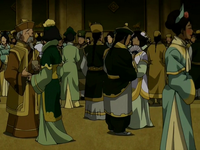
Citizens of the Earth Kingdom tend to have black or brown hair; green, brown, or gray eyes; and often have dark skin tones, though many nobles have lighter complexions.
Traditional colors worn throughout the kingdom range from vibrant greens and yellows to more muted beiges and browns. The people usually style their hair comfortably for work or elaborately for striking impressions. Members of the army wear green and beige uniforms that may have yellow touches to them and they hide their hair in a conical helmet. However, fashions in the Earth Kingdom vary greatly from one region to another. In the West and South, men typically wear their hair in a top-knot, ornamented with various holders and pins, and they often have beards and/or mustaches. Women living in western and southern parts of the Earth Kingdom wear their hair down or piled on top of their head. In Ba Sing Se, however, women usually wear their long hair wrapped around a support, embellished with tassels or flowers; men usually don a plain queue.[37] Omashu citizens typically wear tunics over a long robe or pants, with their hair hidden by a small turban or hat.[38] Farmers and other laborers wear conical straw hats secured to their heads by a string to protect them from the sun.
National emblem
The national emblem of the Earth Kingdom is a square inscribed with a circle, at the center of which is a much smaller square, like with a Chinese coin or the 'Rock' Pai Sho tile. Its many layers symbolize the "depth" of the Earth Kingdom, both literally and figuratively; the insignia represents the "immeasurable layers of deep rock and minerals which earthbenders manipulate to maintain their great cities", as well as the depth of the inhabitants' commitment toward a peaceful and productive way of life.[39] This emblem can be seen on the helmets of Earth Kingdom troops.
Large "coins" of this design made of rock or earth are sometimes used as weapons by earthbenders.[24][40]
Earth Kingdom currency consists of gold, silver, and copper pieces of varying sizes, which are used by Earth Kingdom citizens to purchase goods and services; they are fashioned in the shape of the national emblem, though gold pieces have four notches on the edge, giving them a flower-like shape.[41]
Geography
The geography of the Earth Kingdom varies tremendously due to its immense size. The northwestern areas are mountainous and covered in dense coniferous forests[42] with the only known settlement in the area being a merchant town, while the western coast harbors a warmer climate and many deciduous forests.[43] The inland west is also home to several swamps[31] and the arid Great Divide, while the center of the Kingdom is comprised of the enormous Si Wong Desert.[22] The southwestern coast is covered with lush forests – however, a rain shadow leaves the Kolau Mountains and areas to the southwest as arid mountain ranges with sparse grasslands – the only major settlement in the area being Omashu.[38] The southern coast is a lush area filled with rivers and forested areas, populated by wealthy towns like Gaoling; north, over the mountains, the land turns to sparsely populated plains which once again meld into the Si Wong Desert. The northeast is mostly uninhabited beyond Ba Sing Se. The Earth Kingdom borders the United Republic to the east, which was formerly part of the Kingdom.
Natural resources
Though at first glance they would appear to be the simplest of substances, rock and stone turn out to be the Earth Kingdom's greatest natural resources. As such, they are widely used and manipulated to many ends, from tools to entire metropolises. While the Earth Kingdom as a whole does not make use of fossil fuels nearly as much as the industrialized Fire Nation, coal is mined in certain villages for fuel.[44] The timber of their forests also serve as fuel along with being lumbered for building. By 174 AG, the Kingdom's vast mineral wealth was among the most sought after commodities by the other nations, primarily by the United Republic of Nations.[15]
Architecture, farming, carpentry, hunting, and mining are among many significant Earth Kingdom industries. Its citizens have managed to develop an advanced trade and commerce system so that almost all may benefit. From the complex sewage and postal system of Omashu,[2] to the Ba Sing Se metro transit stations, and various inventions and their inventors, such as the mechanist, all serve as demonstration of the Earth Kingdom's surprisingly sophisticated society.
An abundance of fresh vegetables grows in the rich fertile soil, and fruit and nut trees are plentiful. Animals thrive in the lush forest and farmlands, providing beef and poultry to add to the fruits and vegetables.
Politics
Government
Government system: Confederate Constitutional Monarchy
Head of state: Earth monarch
Head of government: Grand Secretariat of Ba Sing Se
The Earth Kingdom is a large nation divided into provinces[24] and semi-autonomous major cities such as Omashu and Zaofu. The capital of the Earth Kingdom is Ba Sing Se. While there is a central ruler of the entire Earth Kingdom, known as the Earth King, who lives in Ba Sing Se, the city of Omashu is known to have its own king as well.[2] While the Earth Kingdom is definitely shown as being interwoven militarily, bureaucratically little or no influence seems to be exerted upon the constituent towns and regions by the imperial government, especially outside of the major cities. Isolated regions like the Si Wong Desert are havens for criminals, and many agricultural regions have little or no contact with officials from the central government.[22] In addition, the Earth Kingdom has no unified system of laws, with each town having its own legal code.[26] Complex organization within the government is not seen outside of Ba Sing Se and its surroundings, such as Full Moon Bay.
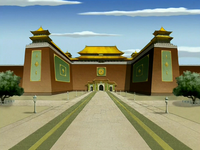
The Royal Palace.
The decline of imperial power was coupled with the decline of the personal power of the Earth King, as successive kings delegated their authority to the bureaucracy in favor of pleasure-seeking and leisure.[45] During the conspiracy of Ba Sing Se during the reign of the 52nd Earth King, the Earth King had little true power, and while he was greatly revered, most of the governmental power in Ba Sing Se was entrusted to various advisers and counsel under the control of Long Feng, the Grand Secretariat of Ba Sing Se and head of the Dai Li. Within Ba Sing Se, the government had near total control, with Long Feng using the Dai Li to suppress dissent and talk of the Hundred Year War, turning Ba Sing Se into a police state. In order to promote the idea of Ba Sing Se as a peaceful utopia, forcible elimination of opposition through methods such as brainwashing were used. The government of Ba Sing Se was incredibly bureaucratic, since it took at least six to eight weeks to process a request to meet with the king (though this may have merely been an effort to stall Team Avatar).[5]
After the end of the Hundred Year War, the system was reformed, with the Earth King having full power once again.[30][34][46] During her rule, Earth Queen Hou-Ting took to exercising tighter authority over all the kingdom's provinces and regions, being aware of noncompliance with her rules in regions outside of Ba Sing Se.[12] After she was assassinated by Zaheer, a power vacuum formed in the Earth Kingdom's government while the nation descended into a state of anarchy.[36][13]
Over the course of three years, anarchy swept through the country, with large, organized bandit groups terrorizing the populace. In an effort to reestablish order, Kuvira was appointed as interim president to reunite the country. By 174 AG, she had successfully united ninety percent of the Earth Kingdom, convincing the other nations it was safe enough to reestablish the Earth monarchy. At the coronation of Prince Wu, Kuvira was to step down in favor of the reinstated monarch. She refused, however, stating Wu was unfit to rule and that the archaic government of Earth Kingdom was the very reason that it collapsed. She proceeded to declare that the Earth Kingdom was no more, proclaiming the establishment of a new "Earth Empire" under her rule.[15]
Royal Earthbender Guards
- Main article: Royal Earthbender Guards
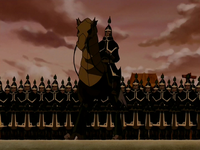
The King's Guards in formation.
The Royal Earthbender Guards of Ba Sing Se, also known as the King's Guards, are affiliated with neither the Dai Li nor the military and instead serve as personal protectors of the Earth King. There seem to be hundreds of them guarding the Royal Palace and they have also functioned as gatekeepers of the Outer and Inner Walls of Ba Sing Se. The guards use specialized surface-to-surface rocks against invaders approaching on foot, but the projectiles are displayed to be able to also serve as surface-to-air rocks against airborne intruders. They sport dark green armor with a green feather at the top of the helmet.[23]
Law enforcement
Not much is known about the law enforcement in the Earth Kingdom. However, during the Hundred Year War, crime seemed to be a daily problem. Thugs and thieves used the chaos of war to rob refugees and peasants in regions uncontrolled by the Earth Kingdom Army. Even in Ba Sing Se, the greatest city in the Earth Kingdom, many citizens and refugees of the Lower Ring felt they had to turn to crime for survival, due to the extreme nature of poverty there.[5] Law enforcement was often left to local authorities[25] and the military,[24] but neither of them succeeded in effectively curbing crime.
The Dai Li
- Main article: Dai Li
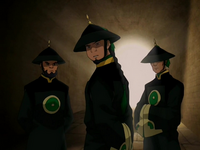
Dai Li agents at the Royal Palace.
The Dai Li are the cultural enforcers of Ba Sing Se, created by Avatar Kyoshi after a peasant rebellion in Ba Sing Se. In addition to distinct uniforms, they are notable for sporting rock gloves and shoes, which can be used to great effect as weapons through earthbending. Though they allegedly serve the Earth King, their loyalty shifted over time toward the Grand Secretariat of Ba Sing Se, especially when Long Feng was in power, and they functioned as a sort of secret police, arresting and re-educating anyone who broke regulations concerning mention of the Hundred Year War.[5] By the time of Earth Queen Hou-Ting's rule, they served as her personal guards and secret police.[12]
Culture
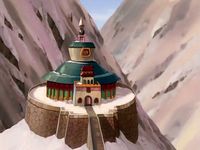
Earth Kingdom Avatar Temple.
From the enforced culture of Ba Sing Se, to the initially isolationist inhabitants of Kyoshi Island,[47] the culture of the Earth Kingdom is far less defined than those of the other nations, a result of its immense size and diversity. Due to their manipulation of earth, which Iroh refers to as the "element of substance",[1] earthbenders are virtually immovable, as reflected in the personality of the Earth Kingdom's citizens. Many hints indicate that the creators of the show based the Earth Kingdom off Chinese and Korean culture, with reference to the hairstyles, architecture, geography, and relations to other countries.
Earth Kingdom architecture varies by province. Like the other nations, it is based on its elemental color, in this case, green. The majority of the buildings are made of stone, wood, and plaster; these may be used in conjunction with one another or separately, depending on the available resources. Most buildings have sloping roofs covered with dark gray or green tiles; yellow tiles denote wealth and are used by aristocrats in Ba Sing Se.[37] The Earth Kingdom insignia is often put on important buildings and fortresses as a symbol of the government. Roads vary considerably – in the country, they are usually made of well-worn dirt, while cities have well-made flagstone streets.
The population of the Earth Kingdom is among small villages, larger towns, and the capital city of Ba Sing Se, which contains a significant portion of its citizens. Tiny villages of ten or so inhabitants dot the landscape; larger towns, such as Chin Village and Gaoling, are found more infrequently. Because of Fire Nation assaults, many of the once great cities of the Earth Kingdom were either destroyed, as was Taku, or taken over, as was Omashu. Smaller towns are usually forced into slave labor by the Fire Nation, to mine coal and ores to build and fuel their warships.[44]
Foods
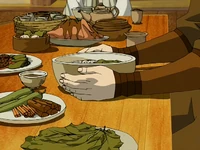
A variety of Earth Kingdom dishes.
As a result of the various minerals the country's soil contains, Earth Kingdom farmers are able to grow a wide variety of foods to support their diets, including vegetables, fruit and nut orchards, and rice, the Earth Kingdom's staple crop. The wild game which thrives within its many dense forests and domesticated animals found on many farms add meat and poultry to the Earth Kingdom citizens' diet. Tea is the most common drink and is made from many plants, including ginseng, leechi, jasmine, and the rare white dragon bush.
Season
Each of the four nations is influenced by their own distinct, dominant season. The Earth Kingdom's dominant season is spring, the time when several living things on Earth are reborn. To an effect, more earthbenders are born during the spring than any other season and their powers are at their strongest during the springtime.
Military
- Main article: Military of the Earth Kingdom
Army
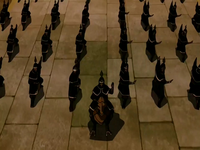
Earth Kingdom soldiers.
Since the Earth Kingdom is geographically the largest of the four nations, it possesses a large variety of combat organizations and personnel.
Like the Fire Nation, the Earth Kingdom armies consist of benders and normal foot soldiers. Soldiers, both benders and nonbenders, carry a wide variety of weapons, from spears, swords, and other various polearms, to more unusual weapons such as hammers, axes, and sickles.
The cavalry consists of ostrich horses, which can vertically climb short distances and run at high speeds. These, along with eel hounds, are also used as transports.
Earthbenders use stones shaped like the Earth Kingdom emblem as artillery and catapult projectiles.[40] These person-sized round coins are invaluable weapons to the earthbenders. The coins can be lined up side by side to make a defensive (and mobile) wall, or stacked to make an impromptu lookout tower. Skilled earthbenders can use these coins as a vehicle and "ride" in the hole in the middle of the coins.
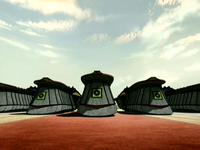
Earthbending-powered tanks, the new heavy weapons of the Earth Kingdom.
During the Day of Black Sun, Earth Kingdom forces assisted in the invasion of the Fire Nation, bringing with them five tanks assembled by the mechanist. These tanks are operated by four earthbenders using their earthbending for mobility and they can carry multiple troops into battle. These tanks have incredibly strong armor and their segmented design allows them to cross any terrain as well as to crush elevated targets. Finally, they have side flaps that open up to allow earthbenders to fire their rock projectiles.[48]
After the Hundred Year War, the Earth Kingdom Army expanded. When Earth King Kuei marched to Yu Dao, his army consisted of several earthbending-powered tanks and modified versions of the hot air balloon.[46]
In 171 AG, after the Harmonic Convergence and the subsequent awakening of new airbenders in the Earth Kingdom, Earth Queen Hou-Ting ordered the Dai Li to kidnap every single airbender to forcefully conscript them into her army, which comprised of military units such as the 1st Airbending Regiment.[12]
Council of Five
- Main article: Council of Five
The Council of Five is a group of five high-ranking Earth Kingdom generals, including Generals How and Sung, who decide the best use of their armies fighting outside the walls of Ba Sing Se. It is the Council of Five who designs and implement any war plans, which includes the best means of protecting the capital city as well as the proposed invasion of the Fire Nation. In addition to this, the Council also controls the King's Guards, an elite force of guards who protect the king. The Council of Five has been together for as long as there has been a king of Ba Sing Se, and up until Long Feng came into power, it has always worked hand in hand with the Earth King to ensure the city's well-being.[23]
Terra Team
- Main article: Terra Team
The Terra Team is an elite platoon of earthbenders under the command of General Sung. They are considered by him to be a capable group. Their uniform differs slightly from regular Earth Kingdom soldiers. During their short appearance when they were called to stop the Fire Nation drill, they were shown to act in a cohesive way, coordinating their attacks. Despite this, they were quickly and easily disabled by Mai and Ty Lee.[49]
Not much is known about the Earth Kingdom Navy, except that it is likely inferior to that of the Fire Nation. The Earth Kingdom's General Fong explicitly stated that invading the Fire Nation with its ships would be suicidal.[40] Three junk ships used by the Dai Li patrolled Lake Laogai.[23] Additionally, given that earthbenders require a physical connection to the earth to bend, being on a wooden or metal boat would render the earthbenders almost totally powerless, unless the ships carried earthen projectiles. Without benders, the Earth Kingdom Navy would be at a severe disadvantage in terms of naval combat compared with the Fire Nation or the Water Tribes.
Air Force
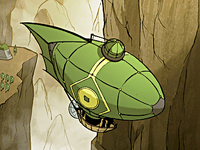
The hot air balloon used by the Earth Kingdom Air Force.
The Earth Kingdom also acquired the specifications for the hot air balloons, which were once Fire Nation exclusives, and incorporated them into their own line of warfare, albeit modified to bear the Earth Kingdom emblem and colors. One such unit was used to carry Earth King Kuei as he led the Earth Kingdom Army to Yu Dao to enforce the Harmony Restoration Movement.[46]
By 171 AG, the Earth Kingdom had acquired airships from Cabbage Corp; although cheaper compared to the ones built by Future Industries, they were less sturdy and easily sustained damage during a fight.[13]
Kyoshi Warriors
- Main article: Kyoshi Warriors
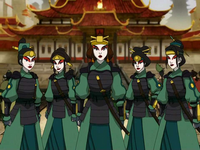
The Kyoshi Warriors.
The Kyoshi Warriors are an all-female group of fighters led by Suki on Kyoshi Island. Their fighting style and clothing mimic those of their founder, Avatar Kyoshi, although the most current fighters do not implement any of the bending arts in their physical movements. Clad in ornate, green armor and Kabuki-like makeup, designed to intimidate opponents, Kyoshi Island Warriors use metal fans as their main weapons. It was later revealed the warriors also utilize katanas and wrist shields. Holding the fans like extensions of their own arms, they aim to turn the strength of their opponents against them, a principle also hinged upon in waterbending. The female warriors do not take kindly to training outsiders, let alone men, in these unique methods. Traditionally, only women are trained as Kyoshi Warriors, however there have been exceptions over the years, such as Sokka.[47]
Kuvira's army
- Main article: Kuvira's army
Following the insurrection of the Red Lotus in 171 AG, Kuvira, former guard captain at Zaofu, was tasked to stabilize the Earth Kingdom in time for Prince Wu's coronation as the new Earth King. As such, she amassed a large army to subdue rampant bandit activity and re-establish order. Due to the severity of the crisis within the country, Kuvira resorted to bribery and intimidation to have state governors sign contracts not only for protection from bandits and sustenance for their hunger-stricken constituents, but also to keep their posts.[6]
Notable locations
Notable figures
|
Trivia
- The Earth Kingdom seems to resemble the Ming and Qing dynasties of China, with buildings in Ba Sing Se that look very much like those in the Forbidden City. Omashu however, is an exception with the city fairly prevalent with pyramid-like structures. However, during Bumi's liberation of Omashu, and Aang's wild ride, it is seen that the buildings within the structures also look like Chinese ones. The people of the Earth Kingdom also possess a Chinese appearance, the king himself wearing the clothing of a Chinese Emperor during the Qing Dynasty. The only notable exceptions are the citizens of Kyoshi Island and King Bumi, with Bumi's wardrobe being exceptionally strange and the people of Kyoshi Island having a more Japanese appearance, as discerned from the name. Also, some of the peasants in the Earth Kingdom, such as Song, have been seen wearing Korean-style clothing.
- The Earth Kingdom was the most focused upon in the series, allowing information regarding culture, military, and diversity to be explored and found.
- The Earth Kingdom seems to run like the Holy Roman Empire, with many smaller kingdoms such as Omashu and Kyoshi Island answering to an overarching ruler.
- The Earth Kingdom national emblem resembles one of the six coins of the Sanada clan emblem (insignia for bravery).
- Since the Earth Kingdom is so large and diverse, it actually holds locations claimed by each of the other three nations within its territory. The Northern Air Temple is in the northeastern Earth Kingdom, the Foggy Swamp Tribe is in a southwestern swamp, and numerous Fire Nation colonies dotted the western Earth Kingdom.
- It is known that there are sixty-seven different royal seals, used on different occasions, depending on the document in question.[45]
- The Earth Kingdom is roughly analogous to the real-world Eurasia.
- The various types of armor and uniform of the Earth Kingdom troops are reminiscent of those of the Manchurian soldiers of the Qing dynasty.
- Earth Kingdom fashion and architecture seems to be influenced by Chinese, Korean, and Japanese cultures. There are also visible influences from Manchu, Mongol, and nomadic cultures from Central Asia that border the deserts.
- The Earth Kingdom has the smallest percentage of benders among the four nations.[50]
- During Earth Queen Hou-Ting's rule, the Earth Kingdom was the only nation that refused to recognize the United Republic of Nations.[12]
Notes
- ↑ Avatar Extras for "The Crossroads of Destiny" on Nicktoons Network refers to Azula as "Earth Queen Azula", meaning that she reigned in the nation as ruler beginning from Long Feng's second incarceration and likely until she left Ba Sing Se. However, Azula was never officially crowned, and thus she can only be considered as usurper.